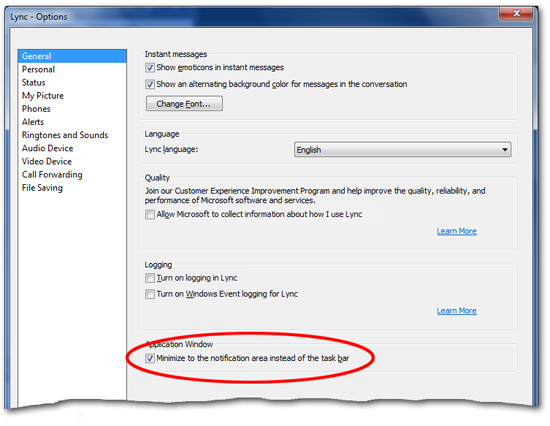Minimize to the notification area instead of the task bar
Registry locations |
HKCU\Software\Microsoft\Communicator\ MinimizeWindowToNotificationArea |
Allowed registry values |
· 0 – Lync is minimized to the task bar when the Contact List is closed · 1 – Lync is minimized to the notification area when the Contact List is closed |
Registry value type |
REG_DWORD |
Default setting |
0: Lync is minimized to the task bar when the Contact List is closed |
This is kind of a tricky one, so let's see if we can explain how it works. Suppose we have Microsoft Lync up and running and we're currently working in the Contact List window. We now decide to minimize that window. As you might expect, Lync gets minimized to the Task bar:
OK, nothing too terribly complicated about that.
Suppose now that we decide to close the Contact List window. As you probably know, closing the Contact List doesn’t actually close Microsoft Lync; instead, and by default, it, well, simply minimizes Lync to the task bar:
In other words, by default, there's no difference between minimizing the Contact List window and closing the Contact List window. In either case, Microsoft Lync gets minimized to the task bar.
So is there anything wrong with that? Not as far as we know. However, there is an alternative. To change this default behavior, go into the Options dialog box and select Minimize to the notification area instead of the task bar, like so:
What happens if you do that? Well, assume you make that change and then minimize the Contact List. That will cause the Contact List to, well, minimize to the task bar:
OK, we admit, that's not very exciting. But now close the Contact List. In that case, Microsoft Lync won't minimize to the task bar; instead, it will minimize to the notification area:
Is that good? Is that bad? Or is that just different? To be honest, that's entirely up to you. But it's an option that's available to you, if you're interested.
Of course, by now you're probably thinking, "Well, that would be an option if I could manage that setting using Windows PowerShell." Well, guess what: you can manage that setting using Windows PowerShell. The following PowerShell script retrieves the current value of the HKCU\SOFTWARE\Microsoft\Communicator\MinimizeWindowToNotificationArea registry value on the local computer. If you'd prefer to retrieve this value from a remote computer, simply set the value of the variable $computer to the name of that remote computer. For example:
$computer = "atl-ws-001.litwareinc.com"
Here's the script for retrieving the MinimizeWindowToNotificationArea value:
$computer = "."
$registry = [Microsoft.Win32.RegistryKey]::OpenRemoteBaseKey("CurrentUser", $computer)
$key = $registry.OpenSubKey("SOFTWARE\Microsoft\Communicator", $True)
$value =$key.GetValue("MinimizeWindowToNotificationArea",$null)
if ($value -eq 1) {$value = "Yes"}
if ($value -eq 0) {$value = "No"}
Write-Host "Minimize to the notification area instead of the task bar: $value"
And here's a script that sets the value of MinimizeWindowToNotificationArea. In this case, the script causes Lync to minimize to the notification area whenever the Contact List is closed; that's done by setting MinimizeWindowToNotificationArea to 1. To return to the default behavior (minimizing to the task bar), just set MinimizeWindowToNotificationAreato 0:
$key.SetValue("MinimizeWindowToNotificationArea",0,"DWORD")
Here's the script:
$computer = "."
$registry = [Microsoft.Win32.RegistryKey]::OpenRemoteBaseKey("CurrentUser", $computer)
$key = $registry.OpenSubKey("SOFTWARE\Microsoft\Communicator", $True)
$key.SetValue("MinimizeWindowToNotificationArea",1,"DWORD")


